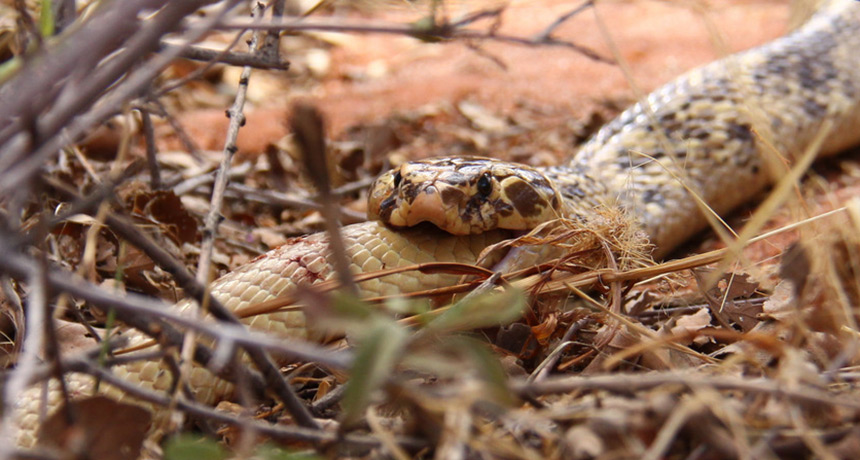How Hannibal the cannibal led to a discovery about cobra diet
A sighting of one cape cobra eating another sparked a study of cannibalism

Scientists working in the Kalahari Desert spotted this cape cobra, which they later named Hannibal, eating a smaller cape cobra. That set off a search for how common the practice of cobra cannibalism really is.
Courtesy of B. Maritz
Studying the diet of snakes isn’t easy. The animals are elusive. They don’t feed all that often. And it probably doesn’t help that some are deadly. So perhaps it’s not much of a surprise that scientists hadn’t realized how common one snack is for southern African cobras. But once they started looking, researchers realized that cobras eating each other — cannibalism — happens far more than anyone had thought.
Bryan Maritz is a herpetologist, or reptile biologist. He works at the University of the Western Cape, in Bellville, South Africa. He hadn’t set out to study cobra cannibalism. His team had been conducting a study in the Kalahari Desert. They were looking at two species of snakes: cape cobras and boomslang. Social weavers are birds. “The snakes raid these huge colonial social weaver nests and eat all the chicks and eggs,” Maritz notes. The researchers wanted to understand better how the two species use the bird nests. As part of their study, they were looking for snakes that they could implant with radio transmitters.
One day this past January, while searching for snakes, the researchers got a radio call. A tour guide told them where to find a pair of large yellow snakes engaged in a fight. Thinking those yellow snakes might be cape cobras, the team raced over. They didn’t find a snake fight. One large cape cobra was swallowing a smaller one. “Instead of capturing two potential study animals, we found one well-fed study animal, now known as NN011,” Maritz and his colleagues write in a paper published October 1 in Ecology. They nicknamed the snake Hannibal.
This wasn’t the first documented sighting of a cannibal cobra. However, scientists had never thought such behavior was common. “The total number of observations of cobras eating in the wild isn’t a big number,” Maritz says. “And the observations of cannibalism in the wild are even rarer. So I think it’s easy to dismiss as a one-off thing.”
But Maritz had an inkling this practice might not be so rare. Before starting the cape cobra-boomslang study, he’d had students dissect museum specimens. They found a surprising number of cape cobras that had eaten other cape cobras. The discovery of Hannibal, though, persuaded him that he needed to investigate just how common the practice was.
Maritz and his colleagues scoured reports of cobra diets in research papers, newsletters and museum bulletins. They also solicited stories on Facebook. Some 30 species of cobras live in Africa and Asia. The team, though, restricted their analysis to six species, including the cape cobra of southern Africa.
Snake-eating, they found, was common among five of the six species studied. Other snakes accounted for 13 percent to 43 percent of the cobras’ diets. Snakes eating members of their own species represented about 4 percent of all prey in the study. All cobra species eat similar things. So the scientists now think cannibalism might be a trait shared by even more types of cobras.
In all the cannibalism events that the researchers witnessed, both the eater and the eaten were males. That leads them to suspect that this behavior may be a guy thing. More research is needed to confirm that. But if it is, Maritz says, “I could see it playing a role in competition for resources or mates. What better way to get ahead in life [than to] eat the guy who is taking your food and mating with females that you might want to mate with?”







